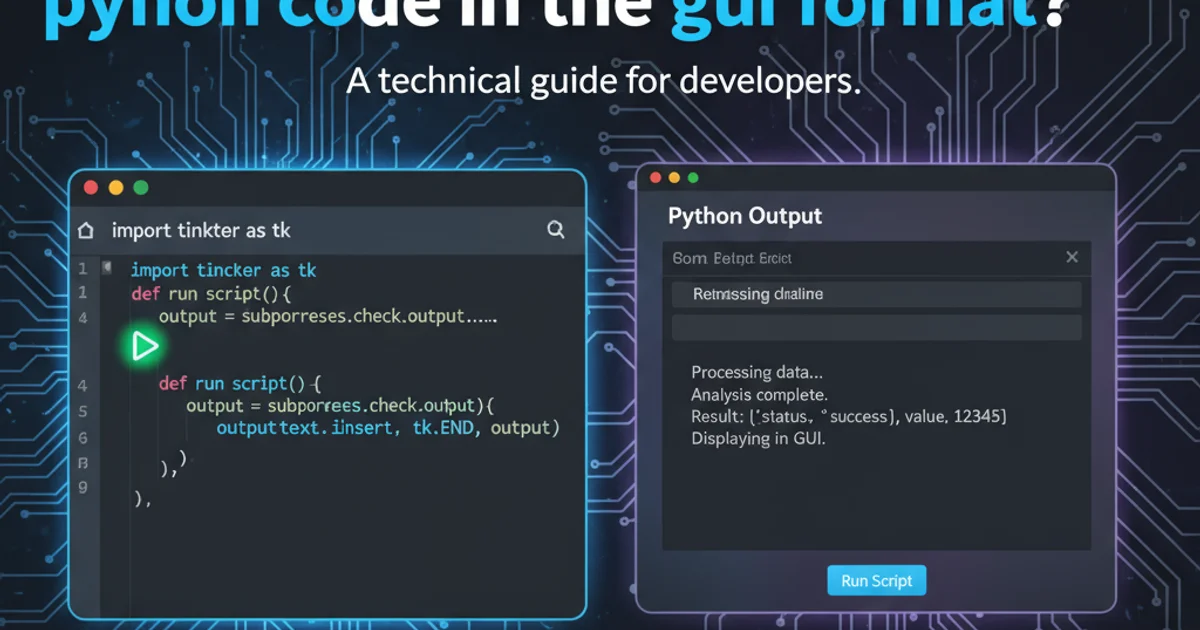How to put output of python code in the gui format?
Categories:
Transforming Python Output into Interactive GUI Applications

Learn how to convert command-line Python script outputs into user-friendly graphical interfaces using Tkinter, making your applications more accessible and interactive.
Python is a powerful language for backend logic and data processing, but presenting its output in a console can be limiting for many users. To enhance user experience and make your applications more accessible, integrating a Graphical User Interface (GUI) is often essential. This article will guide you through the process of taking the output from your Python code and displaying it within a GUI format, primarily using Python's built-in tkinter library.
Understanding the Need for a GUI
When you run a Python script, the results are typically printed to the console. While this is perfectly fine for developers and command-line tools, it's not intuitive for end-users who expect a visual interface. A GUI provides interactive elements like buttons, text fields, and display areas, allowing users to input data, trigger actions, and view results in a structured, visually appealing manner. This transition from console to GUI significantly improves usability and broadens the appeal of your Python applications.
flowchart TD
A[Python Script Execution] --> B{Output Type?}
B -->|Console Output| C[Limited User Interaction]
B -->|GUI Output| D[Enhanced User Experience]
D --> E[Interactive Elements]
D --> F[Visual Presentation]
C --> G[Developer-Centric]
D --> H[End-User Friendly]Flowchart illustrating the benefits of GUI over console output
Introducing Tkinter: Python's Standard GUI Library
tkinter is Python's de-facto standard GUI (Graphical User Interface) package. It provides a robust and easy-to-use way to create desktop applications. Since it's included with most Python installations, you don't need to install any additional libraries to get started. tkinter allows you to create windows, buttons, labels, text areas, and many other widgets to build interactive applications. We'll focus on using tkinter to display the output of a simple Python function.
import tkinter as tk
from tkinter import ttk
def calculate_sum(a, b):
"""A simple function that returns the sum of two numbers."""
try:
return float(a) + float(b)
except ValueError:
return "Invalid input"
def create_gui():
root = tk.Tk()
root.title("Python Output GUI")
# Input fields
ttk.Label(root, text="Number 1:").grid(row=0, column=0, padx=5, pady=5)
entry1 = ttk.Entry(root)
entry1.grid(row=0, column=1, padx=5, pady=5)
ttk.Label(root, text="Number 2:").grid(row=1, column=0, padx=5, pady=5)
entry2 = ttk.Entry(root)
entry2.grid(row=1, column=1, padx=5, pady=5)
# Output display
result_label = ttk.Label(root, text="Result: ")
result_label.grid(row=3, column=0, columnspan=2, padx=5, pady=5)
def show_result():
num1 = entry1.get()
num2 = entry2.get()
output = calculate_sum(num1, num2)
result_label.config(text=f"Result: {output}")
# Button to trigger calculation
calculate_button = ttk.Button(root, text="Calculate", command=show_result)
calculate_button.grid(row=2, column=0, columnspan=2, padx=5, pady=10)
root.mainloop()
if __name__ == "__main__":
create_gui()
A basic Tkinter application to display the sum of two numbers.
ttk (Themed Tkinter) widgets, which offer improved styling and functionality over standard tk widgets, as demonstrated in the example above.Steps to Integrate Python Output into a GUI
Integrating your Python code's output into a GUI involves a few key steps. This process ensures that your backend logic remains separate and reusable, while the GUI handles the presentation and user interaction.
1. Define Your Core Logic
First, encapsulate the logic that generates the output into a function or class. This makes your code modular and easy to integrate with the GUI. Avoid mixing GUI code directly with your core computational logic.
2. Initialize the GUI Window
Create the main window for your application using tk.Tk(). This is the root of your GUI and will contain all other widgets.
3. Add Input Widgets (if necessary)
If your Python code requires user input, add widgets like Entry fields for text input or Radiobutton / Checkbutton for selections. Use grid(), pack(), or place() for layout management.
4. Create Output Display Widgets
Use widgets like Label or Text to display the output. Label is suitable for single-line or short outputs, while Text widgets are better for multi-line or formatted results.
5. Implement an Event Handler
Create a function that will be called when a user action (e.g., button click) occurs. This function should retrieve input from widgets, call your core Python logic, and then update the output display widget with the results.
6. Start the GUI Event Loop
Finally, call root.mainloop(). This starts the Tkinter event loop, which listens for events (like button clicks) and keeps the GUI window open and responsive.